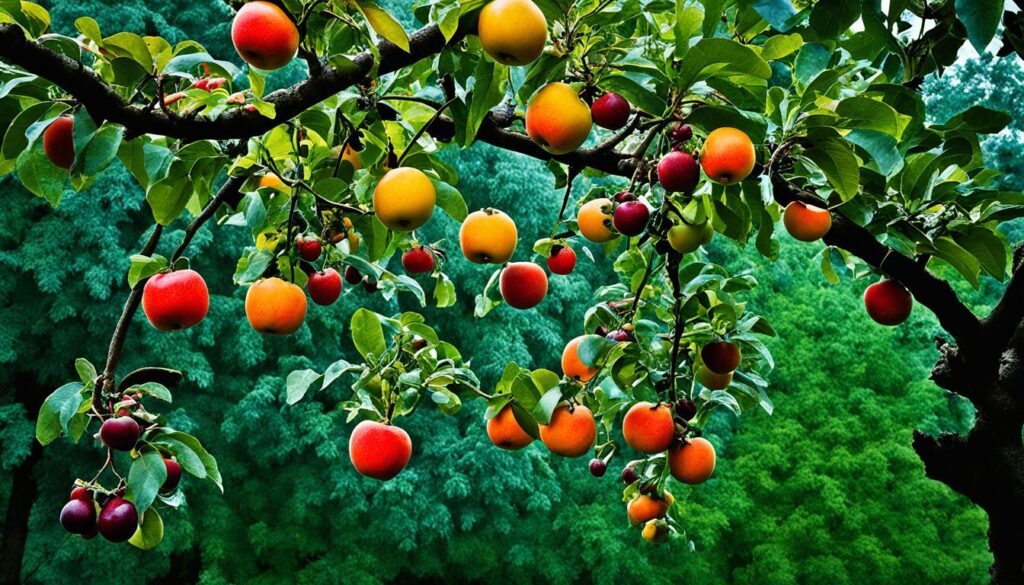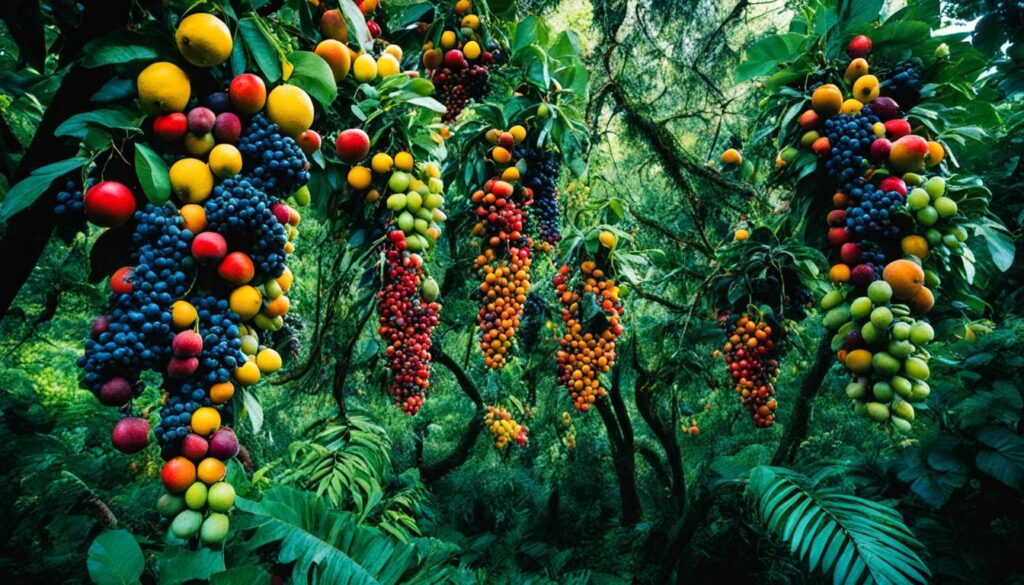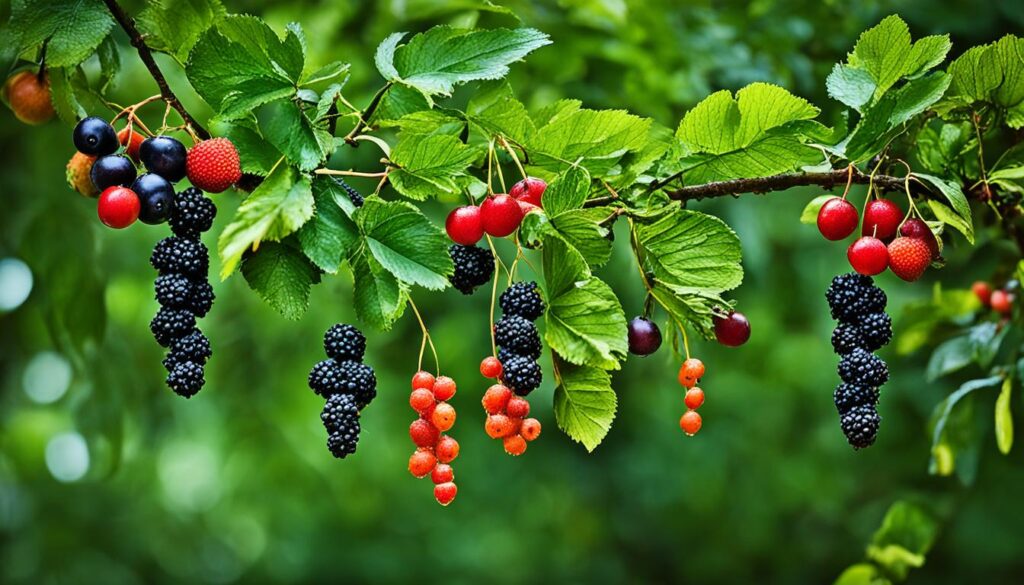Have you ever wondered about the fruits of the forest trees? These fruits are many and come from the trees’ reproductive parts. They carry seeds and feed many living things. You might find nuts, berries, and pods among them.
Knowing about these fruits is key for foraging and identifying different types. It also helps us value their role in our food and nature.
Understanding Forest Tree Fruits
Learning about forest tree fruits is key to seeing their big role in nature. These fruits feed many animals and provide homes for them too. The types of forest tree fruits include everything from juicy berries to hard nuts. You might find fruits like apples, grapes, and berries, each playing a unique part in nature.
Knowing when and how forest tree fruits grow helps you understand when they’re ready. Some trees, like apple trees, take years to produce fruit. Others give fruit sooner. The nutritional value of these fruits is crucial for animals and people alike.
Studying these fruits deepens your knowledge of the forest and its uses. It shows how they’re used in cooking and traditional medicine. This knowledge helps us value nature’s gifts more deeply.

What is the fruit of the forest trees?
The fruit of the forest trees is diverse and vital to the ecosystem. You might ask, what fruits do these trees have? They include sweet fruits like cherries and blackberries, and nuts like acorns and hazelnuts. Each fruit plays a key role in nature, helping with seed dispersal and feeding wildlife.
Learning about these fruits helps us value forest ecosystems more. Some fruits draw in pollinators, creating a relationship that helps with growth and reproduction. This is key for keeping forests diverse. The fruits also feed many animals, helping them survive tough times and keeping the forest healthy.
Let’s explore the different fruits and their roles in the ecosystem:
| Type of Fruit | Characteristics | Ecological Role |
|---|---|---|
| Cherries | Sweet, fleshy fruits | Attracts birds, aids in seed dispersion |
| Blackberries | Edible, juicy berries | Provides food for various wildlife |
| Acorns | Hard-shelled nuts | Food for squirrels, deer, and other foragers |
| Hazelnuts | Nut with a smooth shell | Supports foraging animals and birds |
This knowledge shows us the important links in the ecosystem. It helps us see how forest tree fruits keep these places balanced and thriving.

Types of Forest Tree Fruits
Exploring forest tree fruits shows us many options. These fruits come in different groups, each with unique tastes and uses. Knowing which ones are safe to eat helps make foraging safe and fun.
Common Varieties of Forest Tree Fruits
Many fruits grow on forest trees. It’s important to know these common ones. Some popular types include:
- Berries, such as elderberries and blueberries
- Nuts, including walnuts and chestnuts
- Fleshy fruits, like apples and pears
Each type has its own uses in cooking and for health. They are valuable in both wild and grown settings.
Edible versus Inedible Fruits
Foraging requires knowing which fruits are safe to eat. Some fruits are tasty and healthy, while others are toxic. For example:
- Edible: Blueberries and walnuts
- Inedible: Yew berries and holly berries
Knowing the difference helps avoid mistakes in the forest.
Seasonal Availability of Forest Fruits
Season matters for finding forest fruits. Most berries ripen in late summer. Nuts fall in autumn, making that a good time to pick them. Knowing when to go foraging helps plan your trips better.

Harvesting Forest Tree Fruits
Learning how to harvest forest tree fruits can make your experience better and give you more fruit. It’s important to know the best times to pick fruits like apples and grapes. This way, you get the fruits at their best for picking.
Optimal Times for Harvesting
The best times to pick fruits depend on the fruit type and the local weather. For example, you should pick apple seeds in late summer and fall when they’re plenty. This makes sure the seeds grow well when planted.
Grapes also have the best picking times based on how ripe they are. The season affects when it’s best to gather them.
Tools and Techniques for Effective Harvesting
Having the right tools is key to picking fruits well. You’ll need:
- Pruners for cutting branches and fruits
- Baskets to carry the picked fruits
- Gloves for protection and a good grip
Using good picking methods is also crucial. For berries, pick them carefully to prevent damage. For nuts, you can shake the branches or use a rake to collect the fallen fruits. This way, you get more fruit and keep it in good condition.
Forest Tree Fruit Identification
Learning how to identify forest tree fruits is key for foragers. It helps you tell different fruits apart, making sure you pick safely and well. Look for things like fruit shape, color, leaf shape, and bark texture. Knowing these helps you pick what’s safe to eat and what’s not.
Using guides or online tools can really help with identifying forest tree fruits. This is especially important to avoid picking something poisonous. Knowing what fruits are around you makes foraging more fun and safe.
Here’s a table summarizing key identification factors for different types of forest tree fruits:
| Fruit Type | Shape | Color | Leaf Shape | Bark Texture |
|---|---|---|---|---|
| Apple | Round | Red/Green | Broad ovate | Smooth |
| Cherry | Round | Red/Black | Elliptical | Fiery and smooth |
| Walnut | Round | Green/Brown | Pinnate | Rough and ridged |
| Acorn | Oval | Brown/Green | Branched lobed | Rugged |
Getting to know these traits makes you a better forager. It makes your time outside more interesting and keeps you safe. Knowing how to identify forest tree fruits is a great way to enjoy nature safely.
Forest Tree Fruit Foraging
Forest tree fruit foraging lets you connect with nature and find tasty, healthy foods. It’s important to be careful to stay safe. It’s key to know which fruits are safe to eat. Guides or apps can help tell edible fruits from the ones that aren’t.
Identifying Safe Fruits in the Wild
First, learn about the plants and animals in your area. In places like Nebraska, there are many wild fruits and berries. Here are some tips for foraging:
- Learn what different fruits look like, including their color, size, and smell.
- Use guides to help you find safe fruits.
- Try a little bit of fruit first, but not elderberries, which can be harmful raw.
Your safety should always come first. Knowing which fruits are safe can change your foraging trips.
Guidelines for Sustainable Foraging
Following sustainable foraging rules helps you and the planet. These rules keep nature healthy for the future. Important things to remember include:
- Don’t take too much fruit; leave some for animals and for the plants to grow back.
- Check if you need permission to forage in public places, as some do.
- Use the right containers like shallow buckets or baskets to not harm the fruit.
Responsible foraging in the forest makes your life better and keeps nature safe. By doing this, you help make sure we can all keep foraging in the future.
Forest Tree Fruit Guide: What You Need to Know
Learning about forest tree fruits is key for foragers and health lovers. This guide shows how these fruits can make your meals better and improve your health.
Common Uses of Forest Tree Fruits
Forest tree fruits are very versatile. You can use them in:
- Cooking: Add them to savory dishes.
- Baking: Put them in pies, breads, and pastries.
- Preservation: Make jams or jellies for later.
- Salads: Give your greens a fresh taste.
- Desserts: Make your sweets even tastier with these fruits.
These fruits are not just tasty but also very useful.
Nutritional Benefits of Forest Fruits
Forest fruits are great for your health. They are:
- Full of antioxidants to fight off free radicals.
- High in vitamins and minerals for good health.
- Low in calories, perfect for snacking.
Adding forest fruits to your meals boosts your diet’s nutritional value. For more on growing plants, check out the plant growing guide. It has lots of tips and techniques.
Forest Tree Fruit Flavors and Culinary Uses
Forest tree fruits offer a wide range of tastes that can make dishes better. From the tart cranberries to the sweet wild strawberries, these flavors are great for cooking. They can make your cooking fun and exciting.
These fruits are great for making jams, desserts, and smoothies. Elderberries can be turned into tasty syrups or wines. Acorns add a nice crunch to salads and baked goods. Their unique tastes are perfect for many dishes, making them a must-have in kitchens.
Blueberries are a favorite among forest tree fruits. They are the second most eaten berry in the U.S., after strawberries. There are two types: highbush and lowbush, with highbush being common in stores. These berries are ripe from early summer to late fall and are known for their dark purple-blue color.
They are full of antioxidants, fiber, and vitamin C. This makes them a great choice for those who care about their health.
Exploring the flavors and uses of forest tree fruits can help you cook more. For more info on forest fruit flavors, check out this article about Johnny Weissmuller’s achievements.
| Forest Tree Fruit | Flavor Profile | Culinary Uses |
|---|---|---|
| Cranberries | Tart | Jams, Sauces, Juice |
| Wild Strawberries | Sweet | Desserts, Smoothies |
| Elderberries | Rich, Tart | Syrups, Wines |
| Acorns | Nutty | Baked Goods, Salads |
| Blueberries | Sweet, Tart | Smoothies, Jam, Salads |
Preserving Forest Tree Fruits
Preserving forest tree fruits lets you enjoy their special tastes all year. There are many ways to keep them fresh, each with its own benefits and effects on flavor. Learning these methods can make your experience with forest fruits even better.
Methods for Proper Preservation
Here are some ways to keep forest tree fruits fresh:
- Canning: This method seals fruits in jars and heats them to kill bacteria and stop enzymes. It keeps a lot of the fruit’s original taste but might change the texture.
- Freezing: Freezing saves the fresh taste and nutrients of fruits, great for berries and apples. But, it might change the texture a bit when thawed.
- Drying: Taking the moisture out of fruits makes them last longer. Dried fruits, like blueberries and apples, have strong flavors, but they might lose some juiciness.
Choosing how to preserve forest tree fruits depends on what you like and how you plan to use them. Each method has its own benefits for enjoying these seasonal treats.
Impact of Preservation on Flavor
It’s important to know how preserving affects flavor. Each method changes the fruit in its own way. Here’s what to consider:
| Preservation Method | Flavor Retention | Texture Changes |
|---|---|---|
| Canning | Moderate | Softens texture |
| Freezing | High | May result in mushiness |
| Drying | Concentrated sweetness | Chewy and less juicy |
By picking the right preservation methods, you can keep the bright flavors of forest tree fruits. This way, their unique tastes can be part of your meals even after the harvest season.
The Ecological Importance of Forest Tree Fruits
Forest tree fruits are very important for nature. They are a key food source for many animals, helping to keep forests diverse. For example, the sweet chestnut grows in parts of Romania, like the Subcarpathian depression of Oltenia. It lives in areas between 300 to 700 meters high.
These fruits help keep forests healthy. They help spread seeds, which lets new plants grow. Bats, which make up one-fifth of all mammals, eat these fruits. This helps balance the ecosystem.
In Oltenia, sweet chestnut forests are rare but very valuable. They support many animals and make the habitat richer. Different animals eat these fruits, making a food web that keeps the ecosystem balanced.
Forest tree fruits are crucial for the health of forests. When animals eat these fruits, they help new plants grow. This keeps the environment healthy for the future. We need to protect these fruits and their homes for the next generations.
| Aspect | Details |
|---|---|
| Species | Castanea sativa (Sweet Chestnut) |
| Natural Habitat | Subcarpathian depression of Oltenia, Romania |
| Altitudinal Range | 300 m – 700 m (optimal 600 m – 900 m) |
| Conservation Status | Rare, high conservation value |
| Key Fauna | Bats, birds, and insects |
| Ecological Role | Food source, seed dispersal, habitat enrichment |
Conclusion
Learning about the fruit of forest trees helps us appreciate nature more. These fruits are not just food but also help keep nature in balance. They make our meals better and help the environment.
When you forage responsibly, you get to taste the best of nature. Remember, taking only what you need helps protect the forest. This way, we both enjoy the fruits and keep the nature healthy.
Exploring forest tree fruits is more than finding food. It’s about connecting with nature, saving different plants and animals, and understanding the value of each tree. Every tree is important for our planet’s health.



